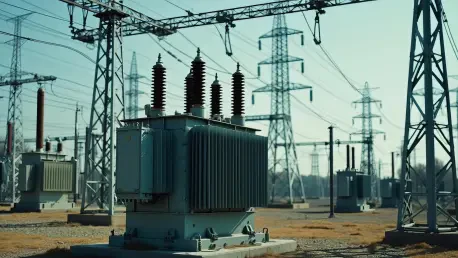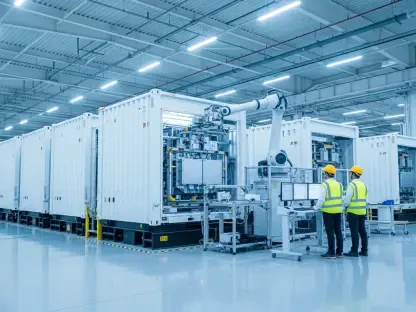The U.S. transformer supply chain is currently grappling with extensive backlogs and persistent challenges that threaten to disrupt both production and distribution. These complications have intensified due to recent shifts in industry trends coupled with geopolitical developments, all compounded by the ongoing repercussions of the COVID-19 pandemic. Within this complex landscape, efforts to alleviate the backlog through reshoring have been initiated; nonetheless, these initiatives have not completely resolved the imbalance between the soaring demand and limited supply capabilities. This scenario underscores the ongoing struggle within the commercial electrical equipment industry to meet increasing demands, heavily reliant on imports amidst geopolitical pressures and logistical disruptions. The unfolding narrative reflects a critical question: can reshoring effectively address these supply woes and chart a sustainable path forward for the industry?
Transformer Backlogs and Supply Chain Challenges
The persistent backlog affecting the U.S. transformer supply chain highlights the intricate issues within the sector, which strive to balance production demands against logistical constraints. Cleveland-Cliffs’ announcement in July 2022, spearheading plans to build a state-of-the-art electrical distribution transformer plant in West Virginia, exemplified an ambitious undertaking aimed at revitalizing the economically challenged region. This project promised substantial job opportunities for hundreds of recently laid-off workers, seemingly positioning the sector for recovery. Yet, less than a year later, Cleveland-Cliffs abandoned the initiative, marking a stark testament to the industry’s volatility and strategic shifts away from non-core markets.
The broader challenges within the commercial electrical equipment sector continue to unfold. Despite signs of recovery post-COVID-19, substantial supply chain backlogs persist, leaving customers with prolonged wait times extending up to three years for high-voltage transformers and approximately a year for distribution transformers. These figures, echoed by experts like Adrienne Lotto from the American Public Power Association and Benjamin Boucher from Wood Mackenzie, illustrate the sector’s reliance on imports, exacerbated by disruptions and geopolitical pressures. A formidable gap persists between supply capabilities and rising demands, partially fueled by reshoring’s complexity in addressing these logistical and strategic conundrums effectively.
Import Dependency and Domestic Production Endeavors
The commercial electrical equipment industry faces a significant challenge revolving around its dependence on imports, underscoring an imbalance between domestic production capacity and demand trajectories. Approximately 80% of high-voltage transformers and 40% to 50% of distribution transformers are sourced internationally, laying bare the vulnerabilities tied to import dependencies. Addressing these challenges through reshoring emerges as a complex endeavor, with industry leaders acknowledging the potential costs amounting to billions and the time required to establish a fully localized production model.
Efforts towards domestic production reflect cautious optimism. Siemens Energy, stepping forward with plans to invest $150 million in its first high-voltage transformer factory in North Carolina, alongside PTT’s expansion of existing manufacturing facilities in the same state, showcases budding initiatives aimed at enhancing domestic capabilities. MGM Transformers and VanTran Transformers, inaugurating substantial manufacturing units in central Texas, collectively represent a strategic push towards bolstering domestic production amidst mounting demand pressures. As the sector navigates this pathway, the focus remains on mitigating import dependencies through sustainable reshoring strategies that align with industry demand forecasts, including a predicted 2% annual growth in electricity demand until 2050.
Industrial Demand and Transforming Markets
The evolving landscape within the industry reflects the robust rise of data centers as transformative forces shaping electrical equipment demand, further amplified by industrial appetites spanning pharmaceutical manufacturing, semiconductors, oil and gas, and renewable energy deployments. Data centers, in particular, represent a burgeoning market, catalyzing mergers such as Mission Critical Group’s absorption of DVM Power + Control in an attempt to bolster its presence within data-centric markets. These shifts reflect a growing prevalence of colocation practices where clients opt for shared facility spaces due to strategic location and service advantages, observed in DVM’s Mid-Atlantic region growth trajectory.
These competitors for electrical equipment resources amplify demand complexities, observed through investment trends in transmission and distribution, where utility spending on infrastructure noticeably increased in recent years. As industrial appetites converge, utilities face mounting pressures, accentuated by renewable energy’s robust positioning and substantial contributions to demand growth. Consequently, industry players are compelled to strategically navigate reshoring and expand domestic production capabilities. Enhancing supply chains remains pivotal as the sector endeavors to balance logistics against evolving market dynamics.
Strategic Responses and Regional Impacts
Amid these multifaceted dynamics, industry experts assert that the sustained demand surrounding electrical equipment mitigates risks associated with reshoring efforts. Investments from Siemens Energy, PTT, MGM, and VanTran are deemed strategically sound, given the prevailing demand-supply dynamics offering promising return forecasts. The logistical advantage inherent in domestic production emerges as a crucial narrative throughout, spotlighting the potential to significantly decrease delivery timelines and ensure reliability against geopolitical uncertainties.
Contrastingly, imports face challenges tied to shipment delays and delivery inconsistencies, highlighting the pitfalls of dependency on international sources, especially from Asia. A critical analysis of these strategic responses underscores the value embedded within localized production, advocating for reshoring as a robust antidote to inefficiencies while emphasizing reliability and dependability. As companies strategically position their manufacturing units closer to U.S. customers, the drive towards reshoring gains traction, fueled by logistical advantages that potentially transform the sector’s capabilities.
Regulatory Shifts and Industry Policy Landscape
Industry policies embody significant shifts reshaping the landscape favorably for domestic manufacturers. Tariff implementations introduced by President Trump complicated import operations while simultaneously offering tailwinds for U.S.-based production initiatives. Import statistics have showcased Mexico’s dominant contribution towards high-voltage transformer imports, alongside Canada’s and China’s diverse electrical component supplies.
Tariffs targeting critical inputs like grain-oriented electrical steel (GOES) spotlight complexities in import dynamics, where Asian producers evade direct barriers by transhipping materials through strategic routes. The subsequent transformation of GOES into transformer cores locally reveals the intricate challenges in reshaping supply chains while serving U.S. consumer bases. Despite the barriers imposed, industry stakeholders strive to navigate these nuances, emphasizing reshoring avenues within evolving regulatory frameworks while committing to compliance with heightened domestic content stipulations championed under President Biden’s administration.
Strategic Outlook and Future Trajectories
The persistent backlog in the U.S. transformer supply chain underscores complex issues, as the sector grapples with production demands versus logistical constraints. In July 2022, Cleveland-Cliffs unveiled plans for a cutting-edge electrical distribution transformer plant in West Virginia, aiming to revitalize the economically struggling area and create jobs for hundreds of laid-off workers. This endeavor appeared to set the sector on a path to recovery. However, within a year, Cleveland-Cliffs abandoned the project, highlighting the industry’s volatility and shift away from non-core markets.
As challenges in the commercial electrical equipment sector continue, supply chain delays remain significant, even after post-COVID-19 recovery signs. Customers now face wait times as long as three years for high-voltage transformers and around a year for distribution transformers. Experts like Adrienne Lotto and Benjamin Boucher point to reliance on imports, worsened by disruptions and geopolitical tensions, leaving a stark gap between supply and demand. The reshoring complexity further hinders addressing these logistical and strategic challenges effectively.









